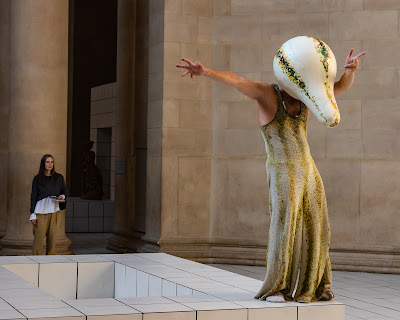The Squash, at Tate Britain, was an immersive installation that recently completed a six month run at Tate Britain. Created by Turner Prize nominee Anthea Hamilton, it combined performance, costume, location and sculpture. Each day a single character, dressed in a colourful squash-like costume, inhabited the Duveen Galleries at the centre of Tate Britain. Over 7,000 white floor tiles had been laid across the length of the Duveens, covering the floor and encasing a series of podiums. Some of these were empty, others had sculptures from Tate’s collection, chosen by Hamilton for their organic forms and colours. Each element of the work had evolved from Hamilton’s interest in a found photograph, for which the original source has since been lost. The image showed a person dressed as what looked like a vegetable lying among vines. Hamilton designed seven costumes that incorporated the colours and shapes of varieties of squash or pumpkin. Daily costume selection was the choice of the individual performer, and their performance was an 'individual presentation of the [squash] character as they inhabited the space and explored their own interpretation of the [inspiration] image'.
I visited the Squash on the Friday before the final weekend. As it was a week day, the Tate wasn't overly crowded, which meant I could get decent shots of the performer alone or with just one or two onlookers. The Duveen Galleries always make an enjoyable space to photograph. The high windows that run the length of the galleries can give some lovely light. The white tiles added an extra dimension to the neo-classical interior, allowing for some interesting frames and lead lines.
I particularly like the first image in this set. It wasn't until I reviewed my shots on Lightroom that I noticed the performer was holding a hand to their ear in an echo of the woman on her mobile. I have no idea if the performer had seen her and was doing this deliberately.
After taking a break, the performer chose to return wearing a different costume.























